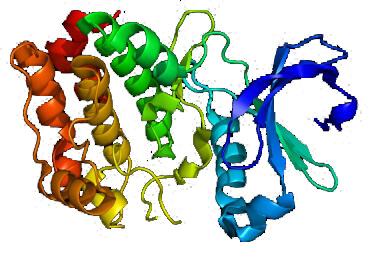Mempro™ Detergent-Free Kinase Enzyme Family Production
As a pioneer and undisputed global leader in membrane protein production, scientists from Creative Biostructure can offer customized Mempro™ Kinase enzyme family production services using detergent-free expression system.
A kinase enzyme bedecking other proteins through append phosphate groups to them is named as protein kinase. With the variation of cellular location, enzyme activity or connection with other proteins, phosphorylation generally leads to a functional change of the target protein. There are approximately 500 protein kinases in the human genome, and they form about 2% of the whole human genes. Nearly 30% of all human proteins possibly can be modified by kinase, moreover, kinases are found to control most of cellular pathways, particularly proteins which are related to signal transduction. Plants and bacteria are able to discover protein kinases as well. A number of structures of protein kinases have been determined and the catalytic subunits are extremely conserved.
 Figure 1. Crystal structure of Serine/Threonine-specific protein lina. (Oncogene
Figure 1. Crystal structure of Serine/Threonine-specific protein lina. (Oncogene
2008)
Creative Biostructure has rich technical experience in high quality Kinase enzyme family production using detergent-free membrane protein expression system, we can perform all kinds of strategies for Mempro™ detergent-free protein production, including:
- Mempro™ Kinase Enzyme Family Production Using Nanodiscs
The Nanodiscs consist of one or more lipids and two copies of MSP which is named after membrane scaffold protein and being used to study isolation, purification and solubilization of membrane proteins. It has been indicated that Nanodiscs enable to deliver porphyrin-conjugated lipid in a fallow form. In addition, delivery of therapeutics is an amazing adhibition of the Nanodisc system.
- Mempro™ Kinase Enzyme Family Production Using Amphipols
Amphipols are a class of oligomers and polymers, moreover they are portmanteaus of amphiphilic polymers. Using amphipols for structure determination of membrane proteins is to make membrane proteins water-soluble by means of trapping them with amphipathic polymers instead of detergents.
- Mempro™ Kinase Enzyme Family Production Using Poly (styrene-co-maleic acid) Lipid Particles (SMALPs)
SMA copolymer is composed of a polymer mixed of maleic anhydride and styrene in all kinds of proportions. As a biochemical approach, SMALP has a significant potential, because it can make membrane bilayers solubilized and implant discs in detergents-free condition.
These novel detergent-free approaches for Kinase enzyme family production can be obtained easily, and enabling more comprehensively structural and functional studies.
Creative Biostructure provides other various Mempro™ membrane protein production services. Please feel free to contact us for a detailed quote.
References:
Dhanasekaran, N., & Reddy, E. P. (1998). Signaling by dual specificity kinases. Oncogene, 17(11), 1447-1455.
Manning, G., Whyte, D. B., Martinez, R., Hunter, T., & Sudarsanam, S. (2002). The protein kinase complement of the human genome. Science, 298(5600), 1912-1934.
Yan, N. (2015). Structural biology of the major facilitator superfamily transporters. Annual review of biophysics, 44, 257-283.
Gaczynska, M., Rock, K. L., Spies, T., & Goldberg, A. L. (1994). Peptidase activities of proteasomes are differentially regulated by the major histocompatibility complex-encoded genes for LMP2 and LMP7. Proceedings of the National Academy of Sciences, 91(20), 9213-9217.